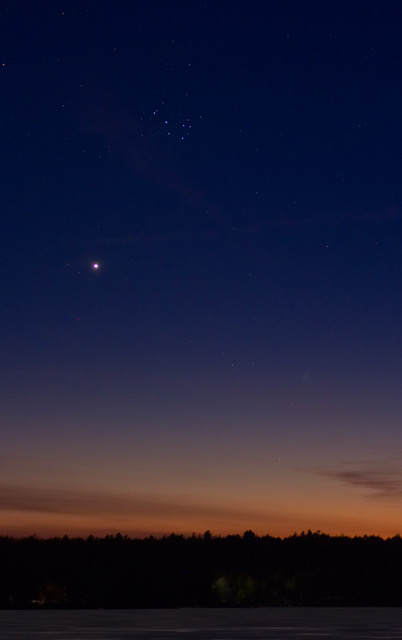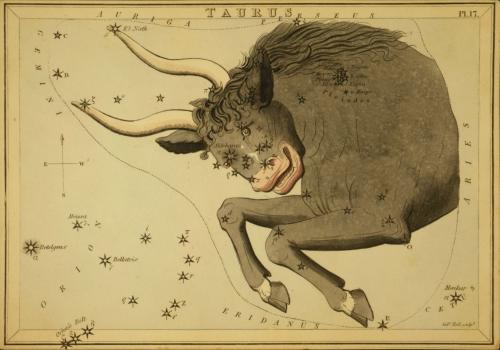
Tonight – May 2, 2018 – the dazzling planet Venus and the 1st-magnitude star Aldebaran – fiery eye of the Bull in the constellation Taurus – pair up in the west after the sun goes down. It’ll be a loose coupling, with Venus passing about 7 degrees north of Aldebaran. A typical binocular field covers about 5 degrees of sky, so the twosome probably won’t fit in same field of view.
If you live at mid-northern latitudes (US, Canada, Europe, Russia), look for Aldebaran to the lower left of Venus.
From latitudes at and close to the equator (0o latitude), Venus and Aldebaran shine pretty much side by side. So look for Aldebaran to the immediate left of Venus.
At temperate latitudes in the Southern Hemisphere (southern South America, South Africa, Australia and New Zealand), look for Aldebaran to the Venus’ upper left.
So maybe you can begin to see that we all see the same sky. It’s just our vantage points on the sky – from our various locations on Earth’s surface – that change the orientation of stars with respect to your local horizon.

The stars of Taurus have been sinking into the sunset behind Venus. Here’s a shot of Venus from April 23, 2018 near another prominent sight in Taurus, the tiny dipper-shaped Pleiades star cluster, also known as the Seven Sisters. Photo by Alastair Borthwick at Lake Kennisis, Ontario, Canada.
What time should you look? As soon as the sky begins to darken. People with exceptional eyesight might see Venus, the third-brightest celestial body after the sun and moon, as soon as 15 minutes (or less) after sunset. Given a clear sky and an unobstructed western horizon, people around the globe will see Venus blazing away some 30 to 45 minutes after sundown.
Aldebaran is fainter. You might have to wait about an hour after sunset to spot it. Although it ranks as one of the sky’s brightest stars, Aldebaran pales next to Venus. Venus outshines this star by nearly 90 times. Binoculars will bring Aldebaran into view faster in the deepening twilight.
Just don’t wait too late to see the pair. They’ll set behind the sun in early evening.
Also, while you’re out there looking west, turn around to spot Jupiter ascending in the eastern sky. Jupiter is the sky’s second-brightest planet. If you have an unobstructed horizon in both directions, you might see both Venus and Jupiter at the same time. As the month progresses, Venus and Jupiter will become easier and easier to view in the same sky. They’ll be like two ends of a seesaw, balancing one another in the May evening twilight.
After this evening, the planet Venus will climb upward, away from the sunset. It’ll adorn the evening sky for many months to come. Meanwhile, the star Aldebaran will sink into the setting sun, to disappear from our evening sky for another season.

The constellation Taurus the Bull. Aldebaran is the Bull’s bright eye. Image via Old Book Art Image Gallery
Bottom line: On May 2, 2018, at nightfall, look for the planet Venus to pair up with the star Aldebaran in the western sky.
Read more: Aldebaran is the Bull’s fiery eye
Read more: Pleiades star cluster, aka the Seven Sisters
Read more: Taurus? Here’s your constellation
from EarthSky https://ift.tt/2KrD74W

Tonight – May 2, 2018 – the dazzling planet Venus and the 1st-magnitude star Aldebaran – fiery eye of the Bull in the constellation Taurus – pair up in the west after the sun goes down. It’ll be a loose coupling, with Venus passing about 7 degrees north of Aldebaran. A typical binocular field covers about 5 degrees of sky, so the twosome probably won’t fit in same field of view.
If you live at mid-northern latitudes (US, Canada, Europe, Russia), look for Aldebaran to the lower left of Venus.
From latitudes at and close to the equator (0o latitude), Venus and Aldebaran shine pretty much side by side. So look for Aldebaran to the immediate left of Venus.
At temperate latitudes in the Southern Hemisphere (southern South America, South Africa, Australia and New Zealand), look for Aldebaran to the Venus’ upper left.
So maybe you can begin to see that we all see the same sky. It’s just our vantage points on the sky – from our various locations on Earth’s surface – that change the orientation of stars with respect to your local horizon.

The stars of Taurus have been sinking into the sunset behind Venus. Here’s a shot of Venus from April 23, 2018 near another prominent sight in Taurus, the tiny dipper-shaped Pleiades star cluster, also known as the Seven Sisters. Photo by Alastair Borthwick at Lake Kennisis, Ontario, Canada.
What time should you look? As soon as the sky begins to darken. People with exceptional eyesight might see Venus, the third-brightest celestial body after the sun and moon, as soon as 15 minutes (or less) after sunset. Given a clear sky and an unobstructed western horizon, people around the globe will see Venus blazing away some 30 to 45 minutes after sundown.
Aldebaran is fainter. You might have to wait about an hour after sunset to spot it. Although it ranks as one of the sky’s brightest stars, Aldebaran pales next to Venus. Venus outshines this star by nearly 90 times. Binoculars will bring Aldebaran into view faster in the deepening twilight.
Just don’t wait too late to see the pair. They’ll set behind the sun in early evening.
Also, while you’re out there looking west, turn around to spot Jupiter ascending in the eastern sky. Jupiter is the sky’s second-brightest planet. If you have an unobstructed horizon in both directions, you might see both Venus and Jupiter at the same time. As the month progresses, Venus and Jupiter will become easier and easier to view in the same sky. They’ll be like two ends of a seesaw, balancing one another in the May evening twilight.
After this evening, the planet Venus will climb upward, away from the sunset. It’ll adorn the evening sky for many months to come. Meanwhile, the star Aldebaran will sink into the setting sun, to disappear from our evening sky for another season.

The constellation Taurus the Bull. Aldebaran is the Bull’s bright eye. Image via Old Book Art Image Gallery
Bottom line: On May 2, 2018, at nightfall, look for the planet Venus to pair up with the star Aldebaran in the western sky.
Read more: Aldebaran is the Bull’s fiery eye
Read more: Pleiades star cluster, aka the Seven Sisters
Read more: Taurus? Here’s your constellation
from EarthSky https://ift.tt/2KrD74W

Aucun commentaire:
Enregistrer un commentaire